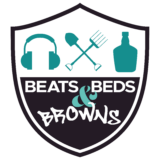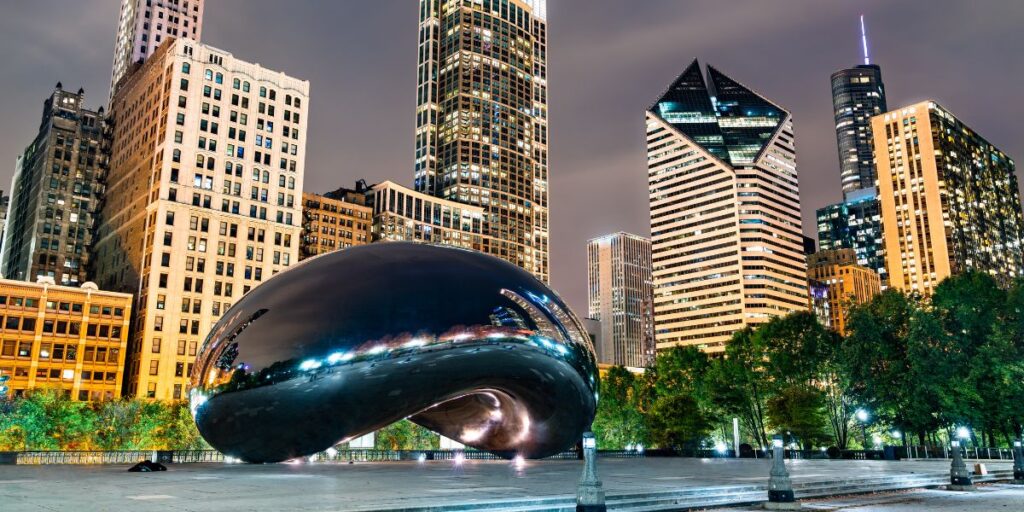In the last 50+ years, the genre of hip hop music has gone from being an intimate experience shared within small clubs to an international stage with a global fan base. During hip hop’s rise to power, the East (New York City) and West (Los Angeles) were battling for dominance on the genre’s public stage, while Chicago was steadily brewing a hip hop culture and influence that would leave a lasting impact.
Chicago’s music roots
Chicago had already made its mark on the music industry through its signature blues sound, born in the open-air market on Maxwell Street in the 1930s. Household artists’ names such as Chuck Berry, Etta James, Buddy Guy, and Muddy Waters were all a part of the Chicago music scene.
Chess Records (owned by the Chess brothers) was the most successful blues record label and popular American music thrived in Chicago during the mid-century modern period of the 1950s-60s. House music, a genre of electronic dance music, is credited as being born in The Warehouse in the West Loop, adding another rung in the ladder to Chicago’s music influence and another step toward creating the vibrant hip hop community thriving today.
The Hip Hop Movement Begins
Experimentation and development of the hip hop genre was happening all throughout the 70s and 80s with rappers and artists honing their craft and style at underground clubs. The elements hip hop is known for, music, graffiti, breakdancing, and DJing were growing in New York City (the birthplace of hip hop) and spreading to other large cities such as Chicago, Atlanta, and Los Angeles. Hip hop music slowly began making radio appearances, and in 1979 Kurtis Blow became the first rap artist to sign with a big record label, Mercury Records. His song “The Breaks” would become the first certified gold rap song.
By the 80s it was clear, the disco days were over, the hip hop days were beginning.
The New World Order
The New York and Los Angeles music scenes were taking notice and opening their arms to what hip hop had to offer, and through the 1980s-2000s developed artist big names and labels such as Run-DMC, LL Cool J, Public Enemy, N.W.A, 2Pac, The Notorious B.I.G, Snoop Dogg, Def Jam records, Death Row Records, Bad Boy Records, and Roc-A-Fella Records. Roc-A-Fella-Records was founded by top-of-the-line artists such as Jay-Z, Damon Dash, and Kareen Burke, and would eventually aid in the rise of Kanye West to fame. Gangsta rap was also developed in this time and remained popular for several decades.
Hip hop was growing and thriving as the East and West coasts battled for dominance, but in Chicago the hip hop community was just as rich, but much more hidden from the limelight. Chicago rappers could go toe-to-toe with any of the coast names, but they struggled to gain traction and respect on a national level. For several years, the hip hop community would gather at clubs such as the Blue Gargoyle on the South Side, and hip hop was expected to be a live, in-person experience. Something needed to be done to elevate this music to the national stage, and that’s just what the Chicago chapter of Afrika Bambaataa’s Zulu Nation called for.
Jitu Jugganot and Lord Cashus D responded to this call by organizing the “New World Order”, a management and advocacy group that was dedicated to getting Chicago rap artists into the spotlight by creating relationships with local music venues and radio stations. An added fuel to this fire was the support of Dr. Groove, Source Magazine’s regional reporter for the Midwest, who agreed to promote Chicago hip hop artists.
It worked. A few Chicago hip hop artists made it through to the public eye and opened the doors of opportunity for many other artists to follow. Over the next years stars of the hip hop scene began to emerge including:
- Ten Tray rap group (led by Jitu Jugganot, they became the first Chicago rap act to sign with a major label).
- Common Sense (now known as Common).
- Tung Twista (known as Twista, who won a Guinness World Record for fastest rapper).
- Da Brat (sold one million copies of her first record, making her the first female solo rapper to go platinum).
- Kanye West (collaborated with other big-name hip hop artists and was a producer at Roc-A-Fella-Records before becoming a household name).
- Chance the Rapper (another household name who has refused to sign with major record labels and remains in Chicago).
A Lasting Hip Hop Legacy
Chicago’s hip hop scene has not only produced some of the biggest names, but a new type of rap known as “Drill”, which came on the scene in the early 2010s, rising to prominence in 2012. Drill is a style of rap that reflects and reveals the harsh reality of life in inner city Chicago, and artists who helped popularize this style include Chief Keef, Lil Durk, and G Herbo.
From small clubs and music venues and late-night lyric building, to fighting for a chance to be heard and respected on an international stage, Chicago hip hop has emerged from the background to leave a lasting impact on the genre and industry. If history is any indication, upcoming rappers and Chicago hip hop artists will carry the torch forward as part of the legacy that came before them, hopeful for what the future may hold.
Chicago hip hop artists are defined by being scrappy and persistent, many of them had to work twice as hard to be recognized and it paid off. Their work ethic and belief in their craft has prevailed and has earned respect from the music industry worldwide. While the Windy City may have once been overlooked for its contribution to the rise, popularity, and richness of hip hop, there can be no doubt that its influence has blown all over the globe.
If you question the legitimacy of Chicago Hip Hop, look no further than the artists of Beats, Beds & Browns. A veritable who’s who of the New Chicago Wave including legends Ju Jilla, Joel Q, A.M. Early Morning, IamGawd, HeavyCrownz, and Rufus Sims. Stay tuned as we continue to explore Chicago Legends and extend our reach, interviewing emerging Hip Hop artists from across the globe.

